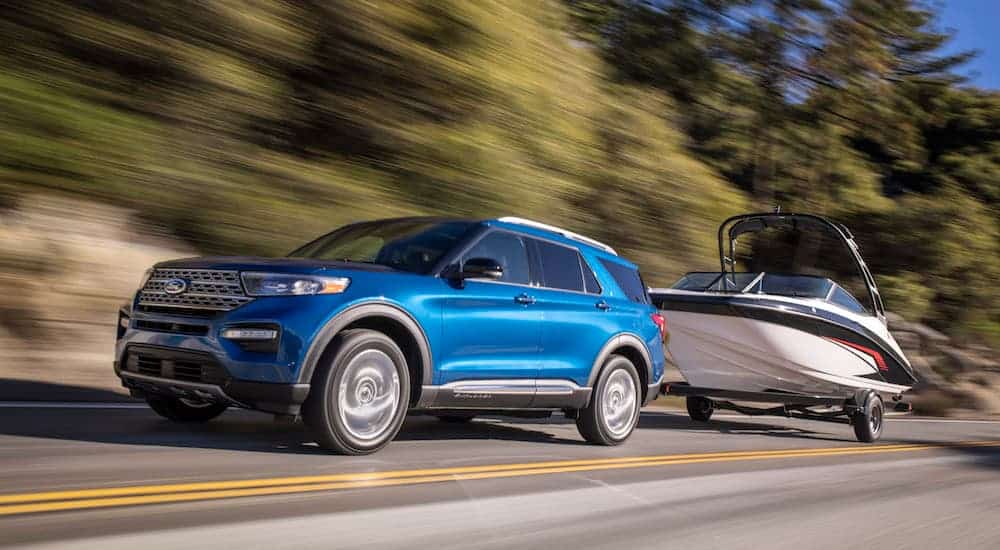Ford and Chevrolet are two of the leading automotive manufacturers in the world today, and the brands have been competing since the time the first Model T rolled off the assembly line in Detroit. This continues, with both companies putting out cars, trucks, and SUVs in the same vehicle categories. For example, Ford F-150 trucks are one of the main competitors of Chevy Silverado 1500 pickup trucks. The same holds true for SUVs, especially in the highly competitive, three-row midsize SUV category. For example, the 2020 Ford Explorer vs 2020 Chevy Trax.
These vehicles perfectly blend form and function, allowing drivers the versatility of carrying large amounts of cargo in the rear and/or holding up to 7 passengers. In many ways, this class has replaced the once predominant mini-van. While it has the carrying capacities of the mini-van, the midsize SUV is more stylish, has better handling, and can handle adverse weather conditions in a better fashion. This is what has made the midsize SUV so ubiquitous in the American suburb. With that in mind, the engineers at Ford and Chevrolet have designed three-row midsize SUVs that offer the same capabilities, Ford with the Explorer and Chevrolet with the Traverse. In the following, we will compare the 2020 Ford Explorer vs the 2020 Chevy Traverse, and show which one is ultimately the better choice to fit your lifestyle and serve your needs.
MSRP and Trim Levels
Ford offers the Explorer in four trims. The base model is the Explorer XLT with an MSRP of $36,675. This model is followed by the Limited with an MSRP of $48,130, the ST with an MSRP of $54,740, and the Platinum with an MSRP of $58,250. In contrast, there are seven trim levels of the 2020 Chevy Traverse. The base model is the Traverse L, with an MSRP of $29,800. The next models are the LS with an MSRP of $32,900, the LT Cloth with an MSRP of $35,400, the LT Leather with an MSRP of $39,100, the RS with an MSRP of $43,600, the Premier with an MSRP of $45,800, and the High Country with an MSRP of $50,900.
While it appears that there is a strong advantage for the Chevy Traverse, some of the points can be misleading. For example, the only difference between the LT Cloth and the LT Leather is the choice of material for the interior of the SUV. Basically, for an extra $4,000, you are getting a Traverse LT with leather seats. Nevertheless, the Chevy Traverse does have lower overall price points than the Ford Explorer.
Engines and Performance
The 2020 Ford Explorer has four different engine options, depending on the trim level chosen. The XLT and Limited are equipped with a 2.3-liter EcoBoost I-4 engine with auto stop/start technology. This will turn the engine on and off in heavy traffic in order to conserve fuel. The 2.3-liter engine is rated to produce up to 300 horsepower and 310 pounds to feet of torque. The Explorer Platinum features a 3.0-liter EcoBoost V6 engine that is rated to produce up to 365 horsepower and 380 lb-ft of torque. The Explorer ST is also equipped with this engine, but the added turbo helps the more performance-oriented ST produce up to 400 horsepower and 415 lb-ft of torque. Finally, Ford offers an optional 3.3-liter Hybrid Engine. This has been rated to provide a range of between 450 and 500 miles on a tank of gasoline. All of the engines also feature a 10-speed automatic transmission.
In contrast, Chevrolet only offers one standard engine on all seven different models of the 2020 Chevy Traverse. This is a 3.6-liter V6 engine operating on a 9-speed automatic transmission. This engine produces up to 310 horsepower and 266 lb-ft of torque. As can be seen, this is actually less powerful than the standard engine on the Explorer XLT and Limited. Therefore, drivers of the higher-priced Traverse RS, Premier, and High Country will actually have a less powerful, less efficient than someone driving an Explorer XLT. The gulf between the performances of the two vehicles widens even further when you compare the Traverse to the Explorer ST and Platinum, with the Explorer ST and Platinum featuring substantially more powerful engines.
The 2020 Ford XLT and Limited are rear-wheel drive, while the ST and Platinum feature Ford’s intelligent four-wheel drive system. This is different from the 2020 Chevy Traverse, which is front-wheel drive standard. Drivers who would like their Traverse to have all-wheel drive will have to pay for an upgrade, even with the more expensive RS, Premier, and High Country models (the Traverse L is only available in front-wheel drive). Moreover, having a 10-speed transmission should give Explorer drivers better handling than the 9-speed on the Traverse.
Fuel Economy
The Chevy Traverse has been rated by the EPA to provide drivers with 18 miles per gallon in city driving, 27 miles per gallon on the highway, and 21 miles per gallon overall. If you opt for an all-wheel drive Traverse, then the numbers drop to 17 miles per gallon in the city, 25 miles per gallon on the highway, and 20 miles per gallon overall. The EPA has estimated that the 2020 Ford Explorer XLT and Limited, with the 2.3-liter engine, will provide 21 miles per gallon in city driving, 28 miles per gallon on the highway, and 24 miles per gallon combined. This is significantly better than the Chevy Traverse. In addition, the four-wheel drive Explorer ST and Platinum are estimated to provide 18 miles per gallon in the city, 24 miles per gallon on the highway, and 20 miles per gallon overall, comparable to the all-wheel drive Traverse. Finally, drivers who opt for the Explorer with the hybrid engine will see fuel efficiency more akin to a subcompact than a midsize SUV: 27 miles per gallon in city driving, 29 miles per gallon in highway driving, and 28 miles per gallon combined.
Towing
One feature that is becoming increasingly popular with SUV drivers is the ability to tow trailers. Whether a mobile home or a boat for recreation, having the ability to use your SUV for this purpose increases its versatility as well as the overall cargo capacity for the vehicle. The 2020 Ford Explorer has been rated to have a maximum towing capacity of between 5,000 and 5,600 pounds, depending on the Explorer’s engine. The 2020 Chevy Traverse is only able to tow up to 1500 pounds, making it less versatile than the Explorer.
Interior Space
Interior space is of paramount importance to this class of three-row SUVs. This is especially so if you are planning on using your Traverse or Explorer for long road trips. Both vehicles have similar configurations, with a 2/2/3 seating for its 7 passengers, going from the front row to the third row. Overall, the 2020 Chevy Traverse has slightly more interior space than the 2020 Ford Explorer, 157.3 cubic feet to 152.7 cubic feet. However, the seating configuration of the 2020 Chevy Traverse actually provides less room for its passengers. For example, front-seat passengers in the Traverse only have 41 inches of legroom and 58.1 inches of hip room, compared to the 43 inches of legroom and 59.2 inches of hip room for front-seat passengers in the Explorer.
This carries over to the second row, where passengers in the Explorer have more room than those in the Traverse, fully 40.5 inches of headroom, 39 inches of legroom and 59.1 inches of hip room in the Ford, compared to 40 inches of headroom, 38.4 inches of legroom, and 56.9 inches of hip room in the Chevy. This may be caused by the Traverse having 23 cubic feet of cargo space behind the third row, compared to 18.2 inches for the Explorer. As such, it seems that the more cramped interior was the result of a design preference.






